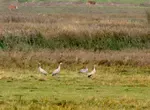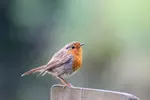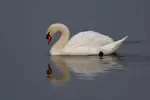- Home
- Northamptonshire walks
- Barnwell
- Great Crested Grebe
Great Crested Grebes: Courtship Dances, Floating Nests, and Fuzzy Chicks
The great crested grebe is one of the UK’s most elegant and captivating waterbirds — known for its striking plumage, floating nests, and enchanting courtship displays.
In this photo story, I follow a pair through their full breeding season, from early courtship rituals to raising fuzzy chicks on their backs.
Have you ever been so entranced by a creature that you find yourself holding your breath, afraid even the slightest movement might break the spell?
That's how I felt the first time I witnessed the elaborate courtship dance of the great crested grebe...
With intricate head-shaking, neck-arching, and synchronised dipping, these striking waterbirds turned the glassy surface of the lake into their own private stage.
In that moment, I knew I wanted more than to simply admire their beauty from afar.
I wanted to truly understand their world.
To follow them through the full cycle of their lives, from that first breathtaking courtship display to the heart-melting sight of newborn chicks riding safely on their parents' backs.
Over the following months at my local nature reserve, I became intimately acquainted with the grebes' remarkable breeding behaviours - through patient observation and the click of my camera shutter.
Now, I’d love to share that experience with you.
Frequently Asked Questions About Great Crested Grebes
🪺 Why do great crested grebes feed feathers to their chicks?
The feathers help form pellets in the chick’s stomach, which trap sharp fish bones and protect their digestive tract. This also slows digestion, aiding absorption.
🎭 What is the grebe’s “weed dance”?
It’s a courtship display where both birds rise from the water, present pondweed, and mirror each other’s movements. It’s a ritual that strengthens pair bonding.
🌿 Where can I see great crested grebes in the UK?
Look for them on still freshwater lakes and reservoirs. Popular locations include Rutland Water, Barnwell Country Park, and many RSPB reserves.
🎧 What does a great crested grebe sound like?
Their calls are sharp, barking or chattering sounds. They’re more vocal during the breeding season.
👶 Why do baby grebes ride on their parents’ backs?
It keeps them warm, dry, and protected from predators. One parent carries them while the other hunts for food.
🪶 How big are great crested grebes?
Adults measure around 50–60 cm long with a wingspan of 85–90 cm, making them the UK’s largest grebe.
Setting the Scene

It was early spring at Barnwell Country Park in Northamptonshire, England when I set out to document the breeding cycle of the Great Crested Grebe.
The park's tranquil lakes, fringed by reeds and willow trees, had been a haven for these elegant waterbirds for generations.
FUN FACT: Did You Know that Great Crested Grebes are said to be closely related to flamingos?
That morning, as I approached the water’s edge, a fine mist still clung to the lake’s surface, perfect for the grebes’ courtship display.
It was more than beautiful. It was deeply significant.
In the 19th century, the great crested grebe nearly vanished from the UK.
Their ornate head plumes were plundered to decorate fashionable ladies’ hats.
At one point, there were just 42 nesting pairs left.
That crisis helped spark the formation of the Royal Society for the Protection of Birds (RSPB) and some of the earliest conservation efforts in British history.
Today, their comeback feels like a quiet triumph and I was lucky enough to witness it firsthand.
The Elaborate Courtship Display
The first few weeks were filled with breathtaking rituals.
I watched, completely entranced, as a pair of great crested grebes rose up vertically in the water— shaking their chestnut head plumes, mirroring every movement in perfect unison.
Sometimes, they would race across the surface of the lake, creating a flurry of spray as they chased one another in a display of energy and grace.
Then came the most touching moment of all, one bird offering a trailing strand of pondweed to its partner, like a gift.
It was a courtship dance like no other. And I couldn’t look away.
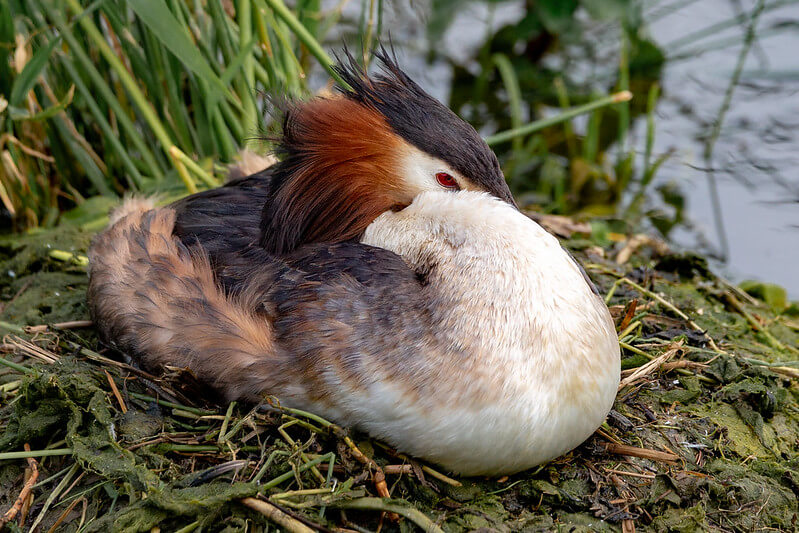 I took this bird's picture from a hide at Rutland Water. The hide let me get up close, giving a much better view of the beautiful head and neck decorations.
I took this bird's picture from a hide at Rutland Water. The hide let me get up close, giving a much better view of the beautiful head and neck decorations.The Great Crested Grebe nesting Phase
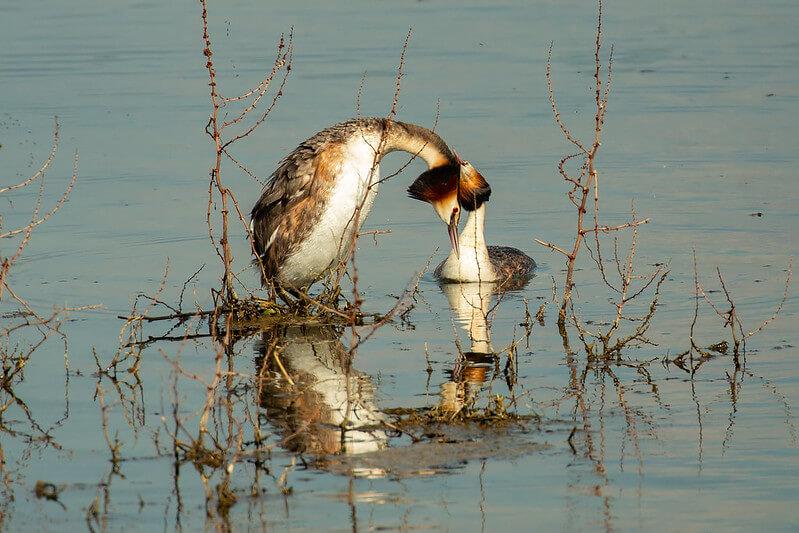 A bonded pair of great crested grebes preparing to nest — their courtship now complete.
A bonded pair of great crested grebes preparing to nest — their courtship now complete.As the courtship period gave way to nesting, I was granted a window into the grebes' exceptional parenting instincts.
With painstaking care, the pair constructed a floating nest from twigs and waterweed anchored to submerged vegetation.
One bird would gathered fresh materials while the other stood guard, fiercely warning off any curious rivals who came too close.
Their cooperation was seamless — a kind of choreography. I watched with admiration as they took turns incubating the clutch of creamy, oversized eggs, gently rearranging them and tucking in new layers to keep them warm.
It was an act of shared devotion, played out in near silence, day after day.
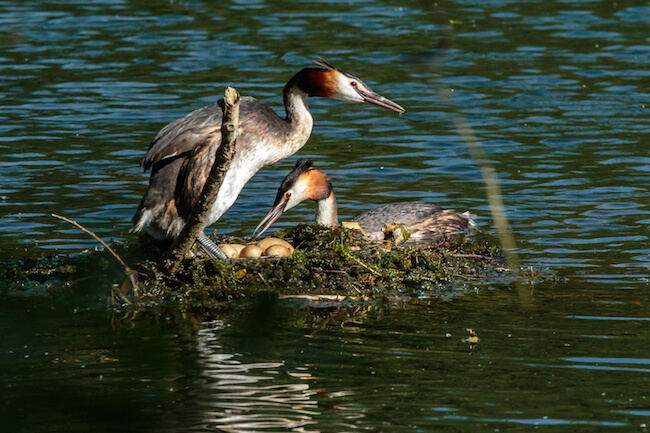 Great crested grebe pair tending to their floating nest, eggs tucked safely beneath
Great crested grebe pair tending to their floating nest, eggs tucked safely beneath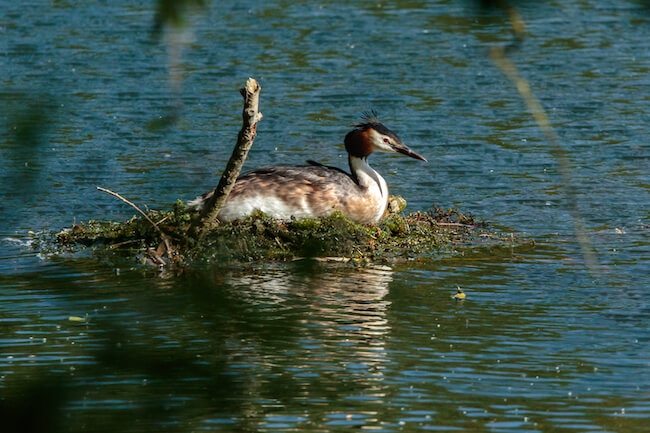 One parent grebe incubating eggs while the other stands guard nearby
One parent grebe incubating eggs while the other stands guard nearbyThe Eggs Have Hatched!
After nearly a month of devoted nest-tending, the first tiny chicks began to emerge.
Within hours of hatching, the striped little nestlings were climbing onto their parents’ backs — instinctively seeking warmth, safety, and shelter from predators. It was like watching a living cradle drift across the water.
This back-riding behaviour has been passed down through generations of grebes, and it was heart-melting to witness it in real life.
I spent hours beside the lake, camera in hand, capturing those first fragile moments — tiny eyes peeking out from under feathers, soft down ruffled by the breeze.
As enchanting as the scene was, I knew it wouldn’t last long. For these young grebes, the challenges were only just beginning.
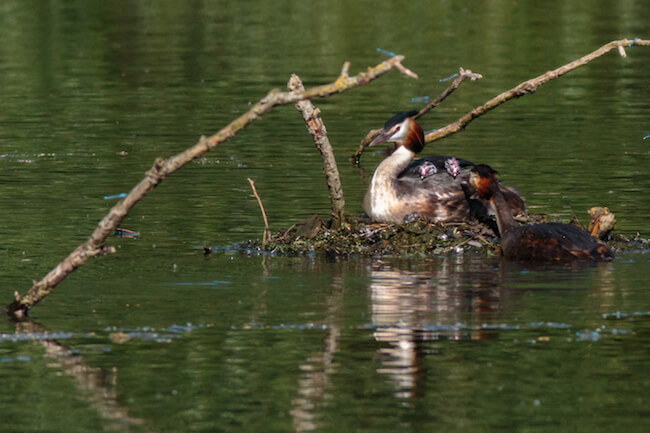 Three newborn grebe chicks snuggled into their mother’s back — the safest seat on the water
Three newborn grebe chicks snuggled into their mother’s back — the safest seat on the waterThe Hazardous First Weeks
Despite their parents' constant care, the first few weeks were anything but easy for the chicks.
Even the smallest misstep could spell disaster. The grebe family had to stay alert, navigating a world full of unseen threats lurking beneath the surface.
I held my breath more than once as they paddled past the shallows, where pike often lie in wait. I watched them huddle together whenever a heron took flight nearby, the chicks vanishing under feathers in a heartbeat.
More than once, I saw the parents respond instantly — bundling their young onto their backs at the first sign of danger.
Luckily, there was no sign of the local otters that week.
Feeding The Family
Both parent birds worked tirelessly, diving again and again to find food for their hungry chicks.
I stood for hours, mesmerised, watching them return with tiny silver fish, crustaceans, and, once, even a small frog held delicately in a sharp pink bill.
Great crested grebes feed mainly on fish, but they’ll also take aquatic insects and invertebrates — whatever they can catch to fuel their growing family.
One behaviour that truly fascinated me was feather-feeding. I watched the adults pluck and offer their own feathers to the chicks.
After researching this strange ritual, I learned it helps aid digestion — the feathers line the stomach, protecting it from sharp fish bones.
The photo below captures one of my favourite moments — slightly grainy from the high ISO, but precious nonetheless. A chick, no bigger than my palm, stretching up to take its meal.
Those tiny beaks can handle surprisingly large prey!
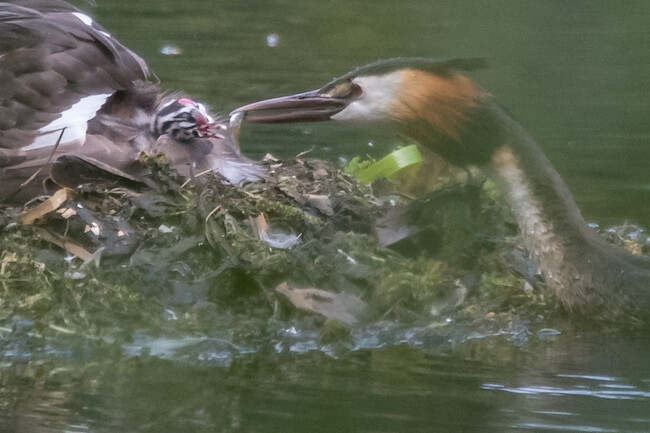 A tiny chick being fed a fish by its parent — a grainy but precious close-up moment
A tiny chick being fed a fish by its parent — a grainy but precious close-up moment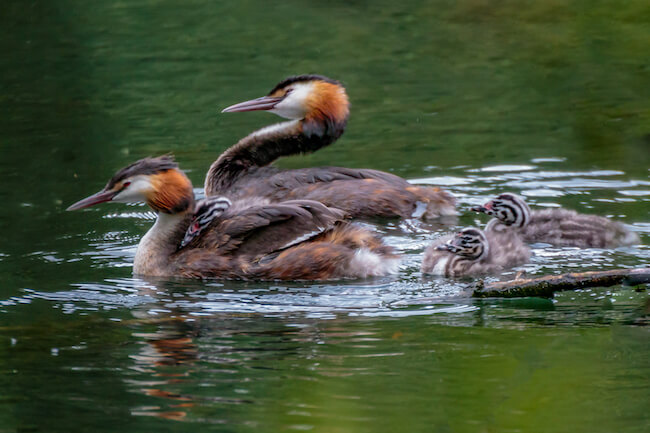 The grebe family moves together across the lake — two parents, three chicks, one perfect scene
The grebe family moves together across the lake — two parents, three chicks, one perfect sceneDay by day, I marvelled at how quickly the fuzzy chicks were growing.
Within a week, their soft down began to give way to waterproof plumage. Soon, they were venturing off their parents’ backs, paddling a little farther each day, testing the water for themselves.
They still stayed close, trailing behind the adults, who kept constant watch.
With their new-found skills came new challenges.
I watched as the family encountered rival grebes — each one fiercely protective of its patch of water.
The adults rose high in the water, wings flared, thrashing and calling in bold displays of aggression. Meanwhile, the chicks instinctively flattened themselves low, waiting for the danger to pass.
It was wild parenting in action — equal parts tenderness and defence.
A Tragic Moment
But even with all their effort, not every chick would survive.
One overcast morning, I arrived at the lake to find only two chicks tucked beneath the adults’ feathers.
The third was gone.
There was no sign of a struggle — just an absence. I scanned the reeds, the water, the shoreline, but the missing youngster had vanished.
Whether taken by a predator or lost to the cold night, I’ll never know.
It was a quiet, painful reminder: nature can be breathtaking… and heartbreakingly unforgiving.
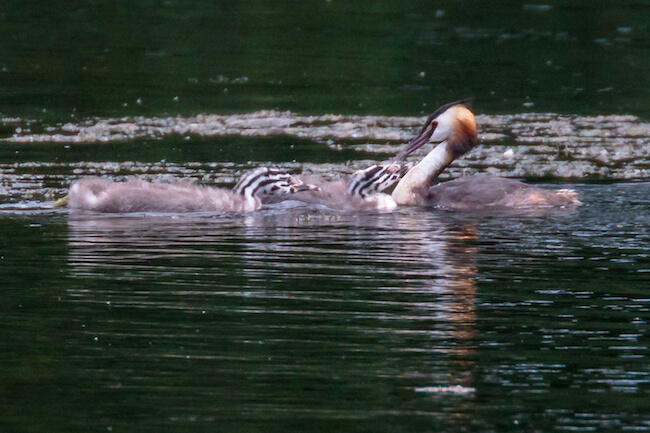 Only two chicks remain — a quiet reminder of how fragile life is in the wild
Only two chicks remain — a quiet reminder of how fragile life is in the wildGrowing Up
As the chicks grew larger, they still tried to catch a ride on their parents’ backs — even when they barely fit anymore.
Their antics became more entertaining by the day.
I’ll never forget the sight of one chubby chick begging for food, paddling furiously, its little bottom bobbing in the air while it called out in high, piping tones.
Have you ever noticed how far back their legs are? It makes them strong swimmers, but hilariously clumsy on land.
Some days, the whole family glided across the lake like a single unit — the two remaining chicks tucked into feathers, or paddling just behind.
It was a heartwarming portrait of togetherness and resilience, framed by rippling water and early summer light.
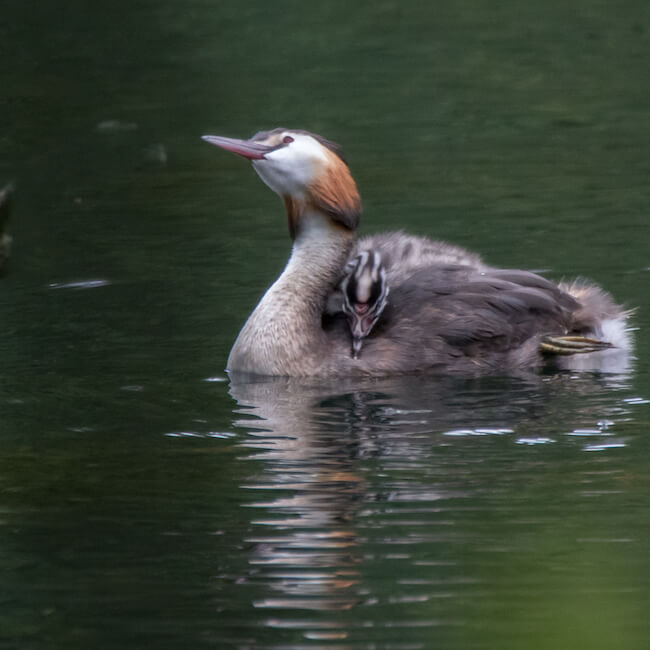 A growing chick still hitching a ride, even as it outgrows the space
A growing chick still hitching a ride, even as it outgrows the space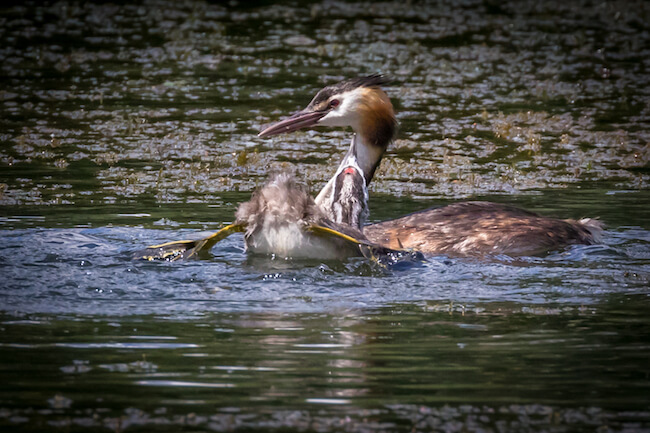 A hungry young grebe begs noisily for food, paddling hard to catch up with its parent
A hungry young grebe begs noisily for food, paddling hard to catch up with its parentTime to Say Goodbye
As summer deepened, the two young grebes gradually lost the stripes from their heads.
Their baby down gave way to sleeker feathers, and they began to strike out on their own — venturing farther from their parents, learning the rhythms of independence.
Soon, they would disperse to find their own territories, armed with all the skills they’d been taught.
I knew my time with them was nearly over.
Then one morning, I arrived to find the lake quiet.
The grebe family was gone.
Only a few stray feathers floated on the still surface — silent traces of the journey we had shared.
As I packed away my camera, I felt immense gratitude for having witnessed their story unfold. From the electric energy of courtship to the soft, sleepy weight of a chick on its parent’s back — every moment had deepened my love for the natural world.
Their cycle of life had closed for the season.
But the memory of it would stay with me always.
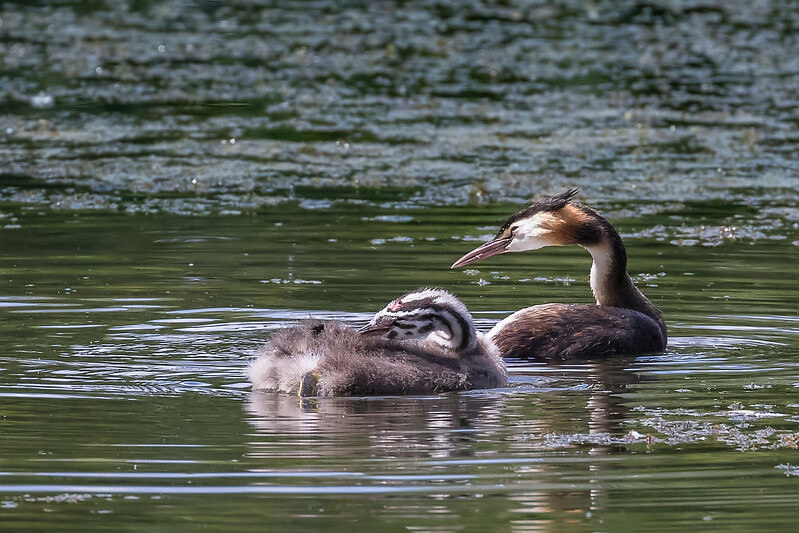 One parent still guiding its growing chick — nearly full-sized, but not yet fully independent
One parent still guiding its growing chick — nearly full-sized, but not yet fully independent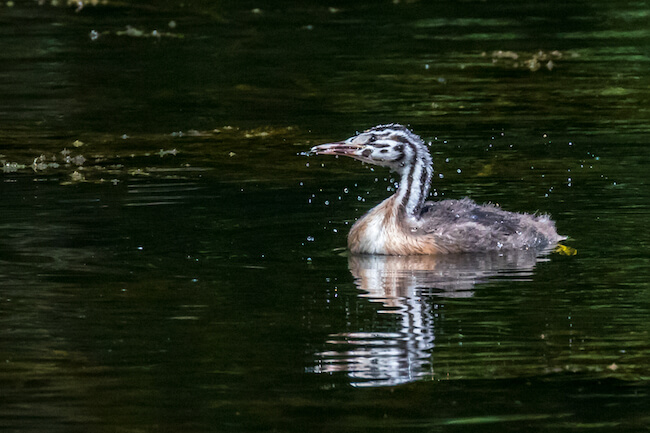 A young grebe chick gives a vigorous shake, sending water droplets flying in every direction
A young grebe chick gives a vigorous shake, sending water droplets flying in every direction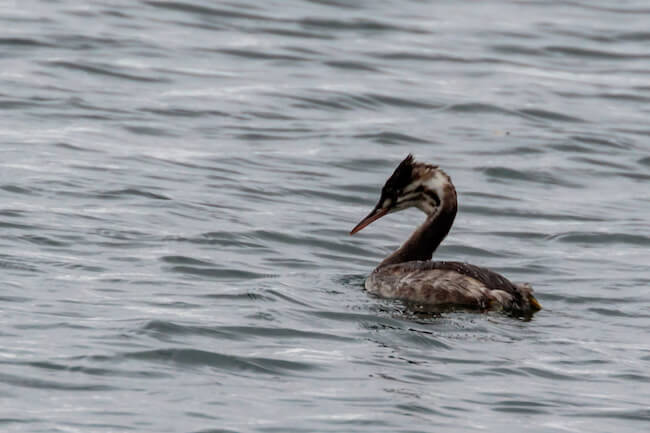 A juvenile great crested grebe, still showing faint head stripes — not quite an adult yet
A juvenile great crested grebe, still showing faint head stripes — not quite an adult yetMy Photography Gear
To complete the story, I thought I’d share a bit about the gear I used to capture these moments.
All the photos were taken with my old Canon 7D Mark II, paired with a 400mm prime lens and a 1.4x extender. That gave me just enough reach to observe the grebes without disturbing them.
I also used a tripod to help keep the camera steady — especially helpful for low light or when waiting for that perfect shot.
It’s worth saying: you don’t need the latest or most expensive gear to enjoy wildlife photography.
This setup is older and second-hand, but it still performs beautifully. What matters most is time, patience, and the joy of watching nature unfold through your own eyes.
Capturing images to look back on is wonderful — but the real reward is being present in the moment.
Enjoy the Beauty of Nature
As I reflect on this journey with the great crested grebes, I’m reminded that nature has a way of slowing us down — in the best possible way.
You don’t need the latest camera gear.
You don’t even need hours of spare time.
Just a few quiet moments, spent outdoors, can open the door to something extraordinary.
Whether it’s the ripple of water, the flick of a tail, or the sound of birds calling across a still lake — the magic is always there. We just have to pause long enough to notice.
So if you can, step outside today.
Take a walk. Find a patch of green. Sit by some water.
You never know what quiet wonders might be waiting.
Further Reading
Related Wildlife Guides
Mute Swans - Learn many surprising mute swan facts about their lives and discover how to take great photos with plenty of detail in those beautiful white feathers.
The Common Crane in the UK - An article covering the history of the common crane in the UK
Related Photography Tips
Golden Hour Photography - Discover the secrets to capturing wildlife photos during the golden hour, that magical time after sunrise and before sunset when the light is warm and soft.
Related Walks & Locations
Rutland Water - An account of a day spent photographing the wildlife at this important reservoir and wildfowl reserve.
Grafham Water - Discover the hidden lake that Great Crested Grebe love to overwinter on.
Paxton Pits Nature Reserve - My first Paxton Pits Nature Walk was a real treat with a lovely surprise at the end.

About the Author
I’m a wildlife photographer who learns on everyday walks. This site is my field notebook: practical photo tips, gentle ID help, and walk ideas to help you see more—wherever you are.
Step Behind the Wild Lens
Seasonal field notes from my wildlife walks: recent encounters, the story behind favourite photos, and simple, practical tips you can use on your next outing.
